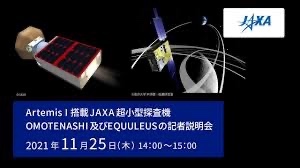
JAXA: Two probe missions!
– Japan’s first moon landing –
JAXA:
It explained the mission of two small probes.
“OMOTENASHI”:
Aiming for Japan’s first moon landing.
Landed by crashing into the moon at about 180 kilometers per hour.
Its mission is to send radio waves to Earth.
“EQUULEUS”
The goal is to reach a special area on the far side of the moon.
We will check whether we can efficiently fly to important places for space development.
NHK | Universe
https://www3.nhk.or.jp/news/html/20220826/k10013789181000.html
JAXA : Deux missions de sonde !
– Le premier alunissage du Japon –
JAXA :
J’ai expliqué la mission de deux petites sondes.
« OMOTENASHI » :
Viser le premier alunissage du Japon.
A atterri en s’écrasant sur la lune à environ 180 kilomètres à l’heure.
Sa mission est d’envoyer des ondes radio vers la Terre.
“EQUULEE”
Le but est d’atteindre une zone spéciale de l’autre côté de la lune.
Nous vérifierons si nous pouvons voler efficacement vers des endroits importants pour le développement spatial.
NHK | Univers
JAXA: Zwei Sondenmissionen!
– Japans erste Mondlandung –
JAXA:
Ich erklärte die Mission zweier kleiner Sonden.
„OMOTENASHI“:
Ziel ist Japans erste Mondlandung.
Gelandet durch Aufprall auf den Mond mit etwa 180 Stundenkilometern.
Seine Mission ist es, Radiowellen zur Erde zu senden.
“EQUULUS”
Ziel ist es, ein spezielles Gebiet auf der anderen Seite des Mondes zu erreichen.
Wir werden prüfen, ob wir wichtige Orte der Weltraumentwicklung effizient anfliegen können.
NHK | Universum
Japan to launch two probes to the moon
Scientists at the Japan Aerospace Exploration Agency, or JAXA,
say they are very enthusiastic about their mission of sending two small spacecraft to the moon.
The leaders of the teams operating the probes, named Omotenashi and Equuleus, met reporters on Friday.
The two spacecraft
will be launched on Monday, Japan Time, aboard a large next-generation rocket called the SLS developed by the US space agency NASA.
Omotenashi
has been developed to become Japan’s first spacecraft to land on the moon.
The probe
will hit the moon’s surface at a speed of 180 kilometers per hour, then send radio waves back to the Earth.
The spacecraft
has been equipped with protective measures, including a shock-absorbing material.
Researchers hope to use data
obtained by the mission to help make future lunar probes smaller and lighter.
Equuleus’s mission
is to reach a specific area on the far side of the moon.
The team wants to see whether the probe can fly to locations important for space exploration without difficulty.
NHK WORLD-JAPAN News